Abstract
Significant disparities in health care based on patient socioeconomic status have been documented. The extent to which physician behavior accounts for these differences is not known. We examined the impact of patient socioeconomic status, measured by years of education, on physician behavior assessed by direct observation of office visits, chart audits, and patient reports among 138 family physicians in 84 practices. Outcomes included time use measured with the Davis Observation Code, delivery of preventive services recommended by the US Preventive Services Task Force, satisfaction assessed with the MOS 9-item Visit Rating Scale, and delivery of attributes of primary care measured by the Components of Primary Care Index. After controlling for patient characteristics among 2538 visits by adult patients who returned questionnaires, a high school education or less was associated with slightly greater proportion of time spent on physical examination and providing nutrition counseling, and less time on patient questions, assessing patient health knowledge, negotiation, and exercise counseling. This indicates that physicians adopt a more directive style with less educated patients. Screening tests were provided at lower rates among less educated patients, but there were no differences in rates of health habit counseling or immunization services delivered and no differences in delivery of patient-reported components of primary care. Less educated patients had similar overall visit satisfaction, but were slightly less likely to have their expectations met. These show that patients' education has relatively small, but potentially important, effects on the outpatient delivery of primary care.
Full text
PDF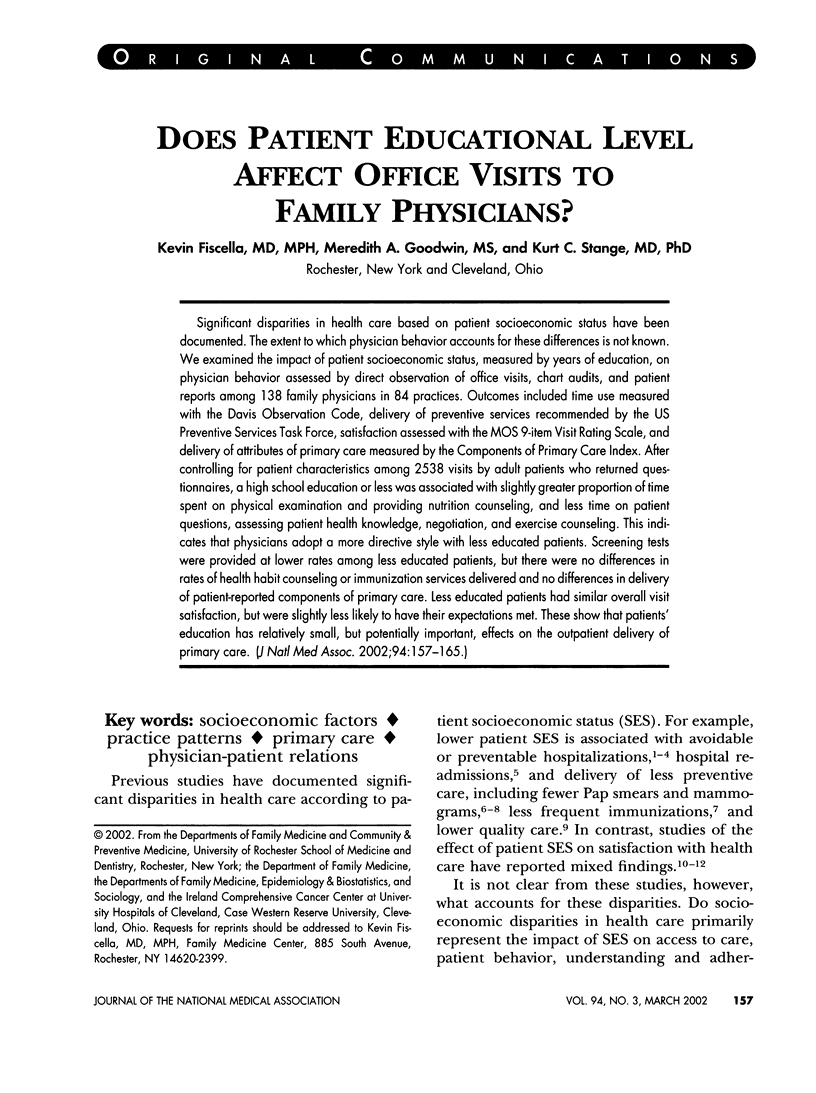
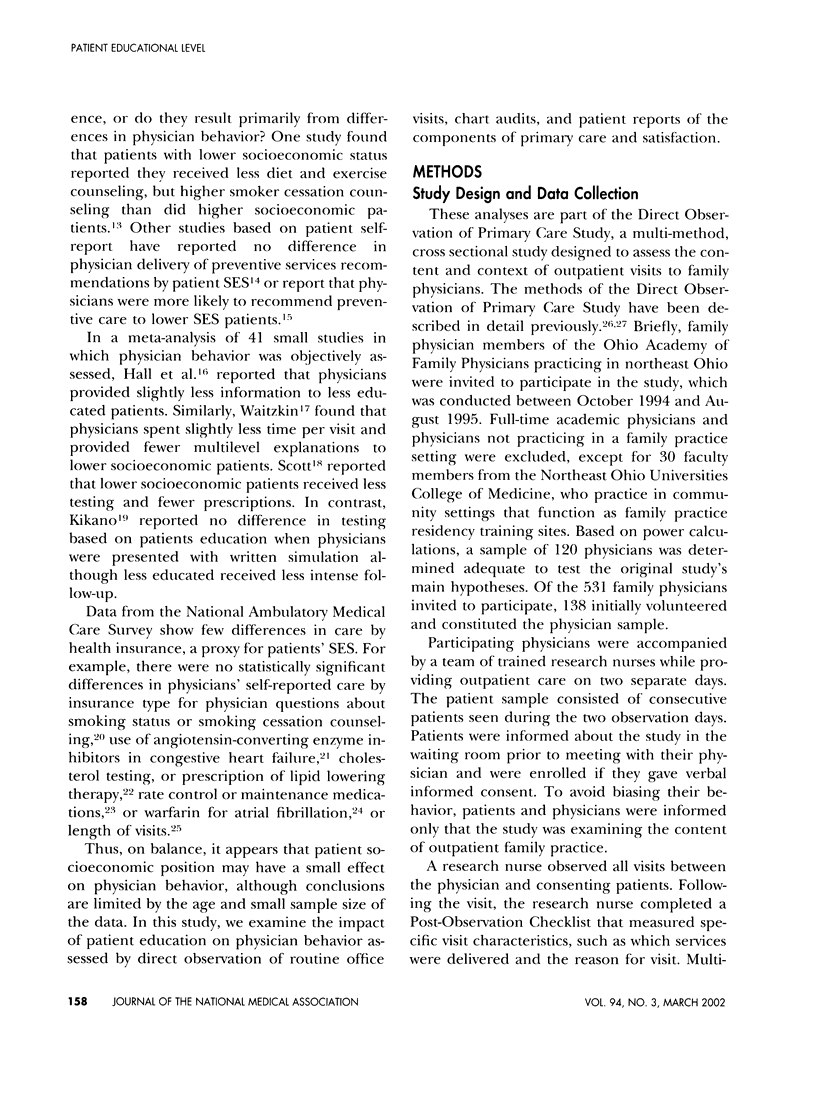
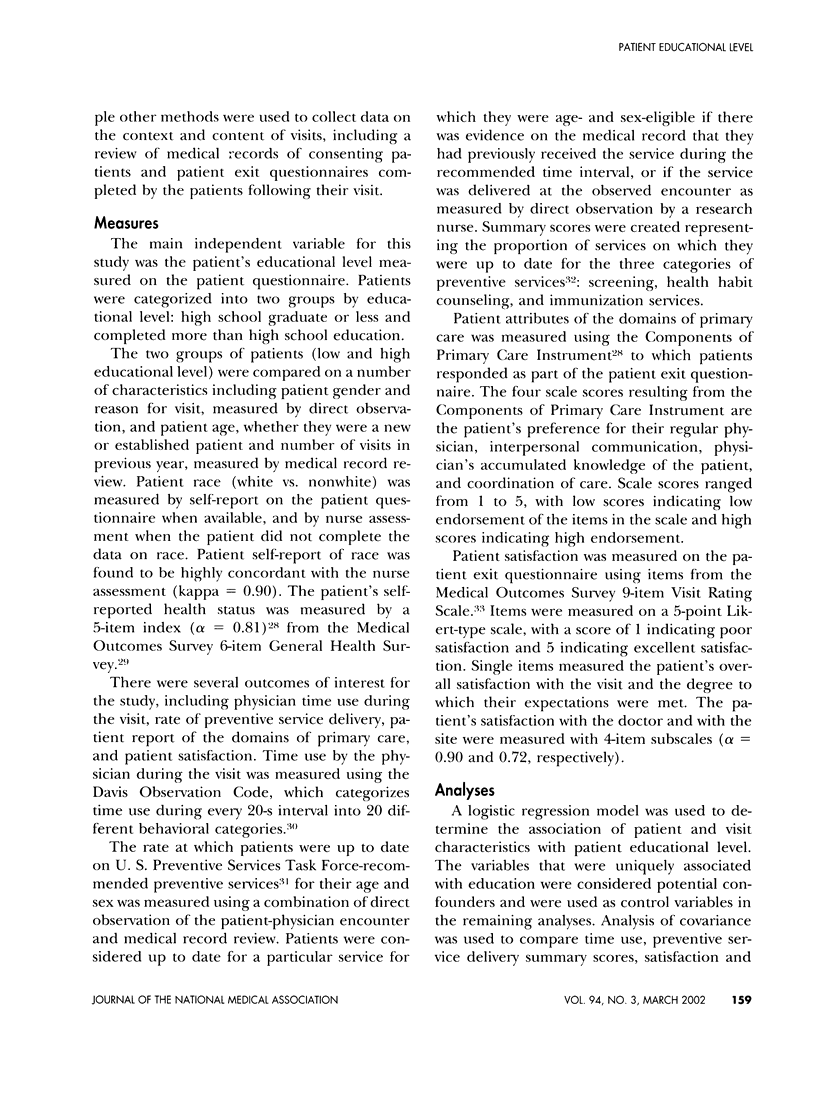

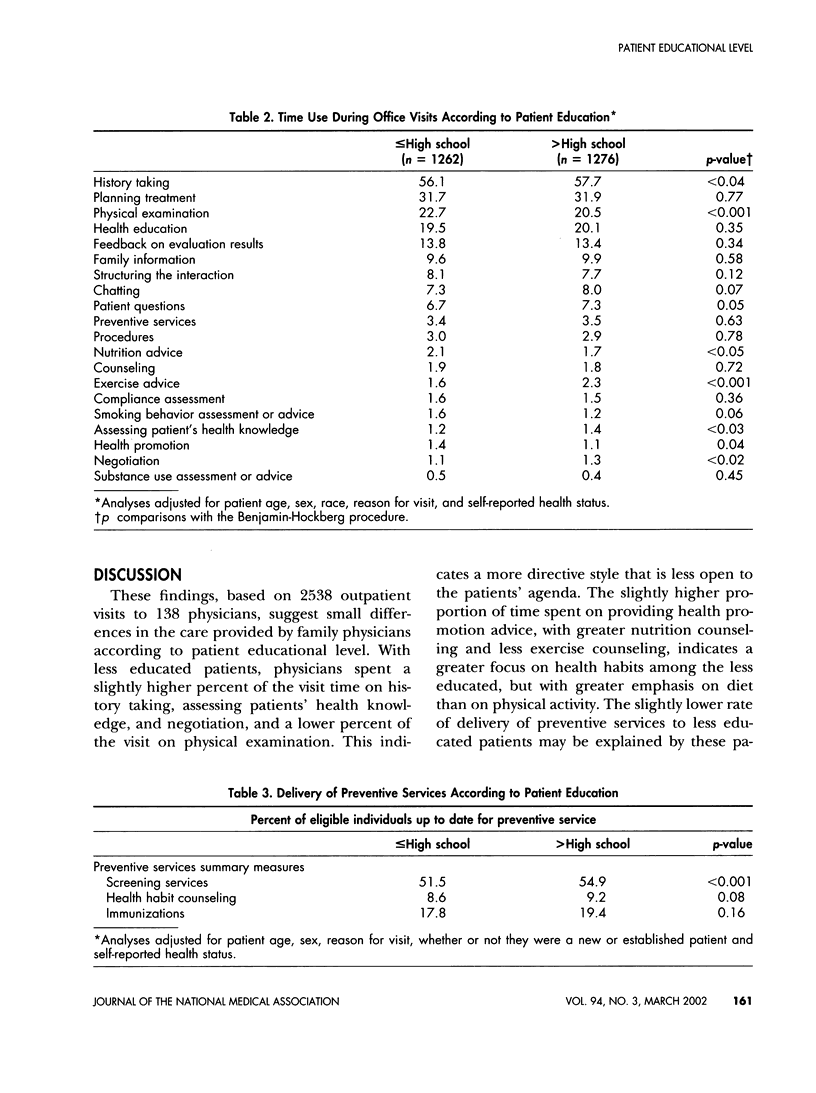
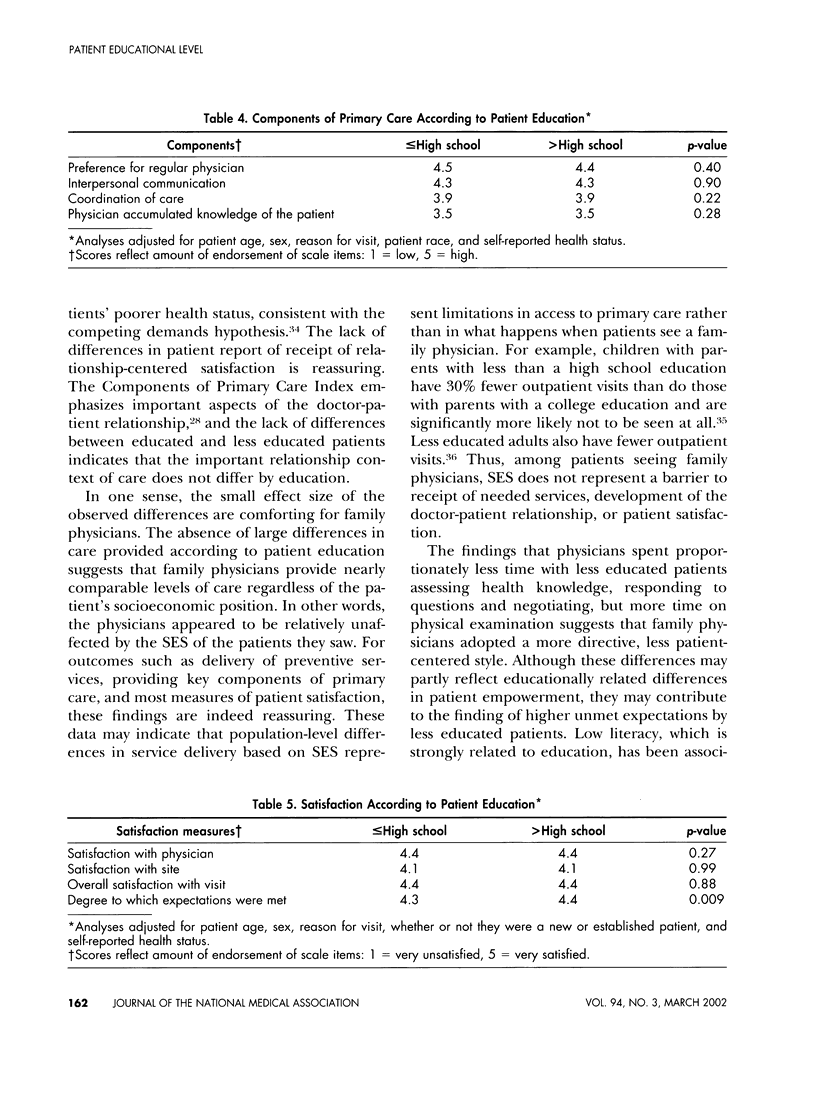

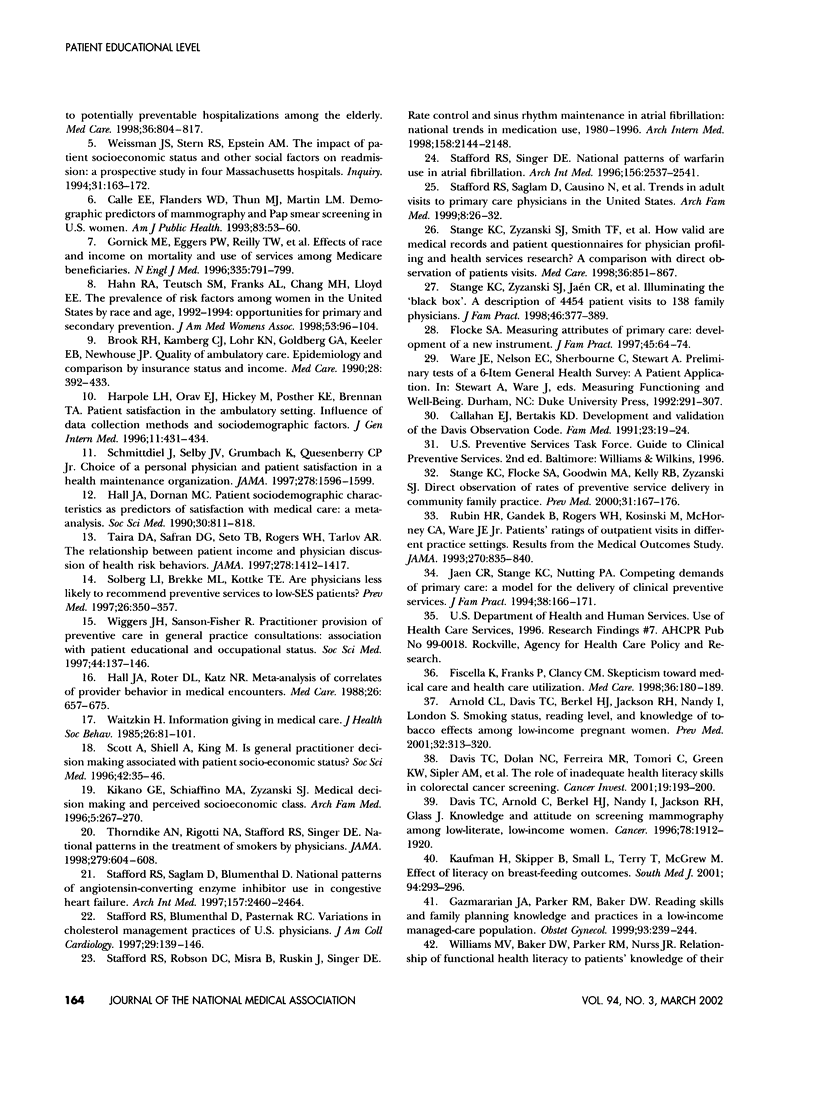
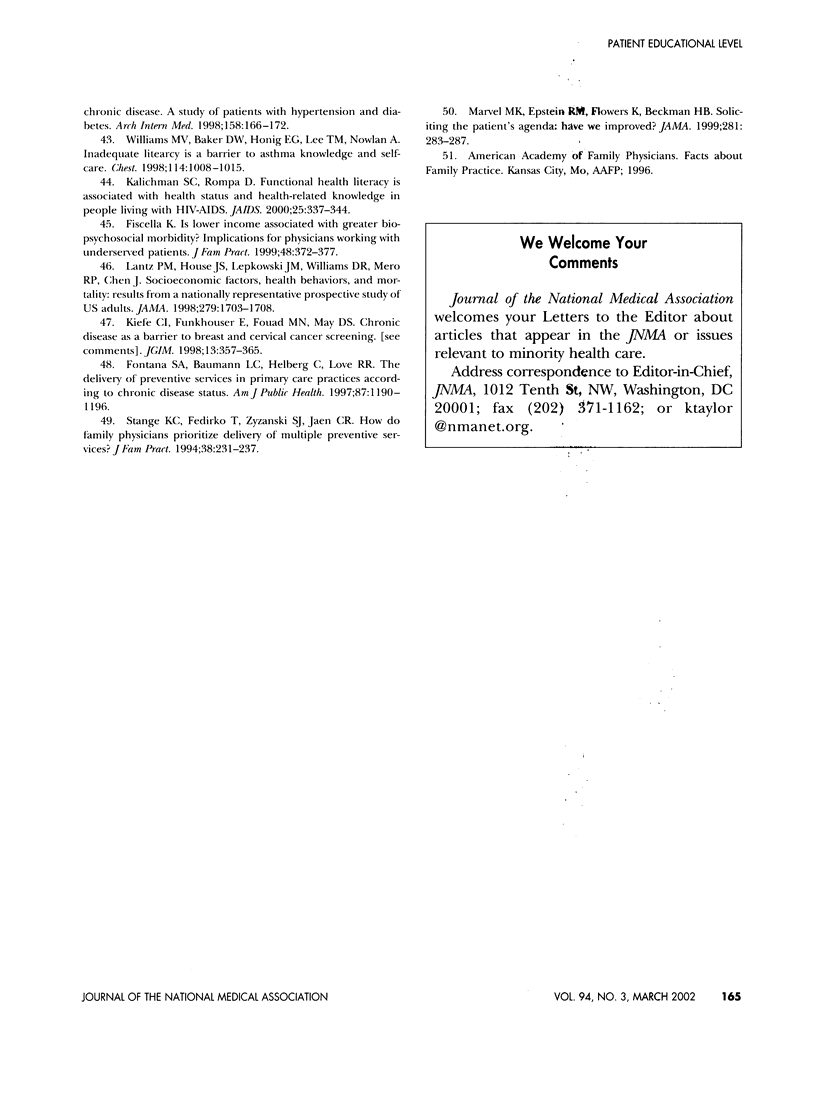
Selected References
These references are in PubMed. This may not be the complete list of references from this article.
- Arnold C. L., Davis T. C., Berkel H. J., Jackson R. H., Nandy I., London S. Smoking status, reading level, and knowledge of tobacco effects among low-income pregnant women. Prev Med. 2001 Apr;32(4):313–320. doi: 10.1006/pmed.2000.0815. [DOI] [PubMed] [Google Scholar]
- Blustein J., Hanson K., Shea S. Preventable hospitalizations and socioeconomic status. Health Aff (Millwood) 1998 Mar-Apr;17(2):177–189. doi: 10.1377/hlthaff.17.2.177. [DOI] [PubMed] [Google Scholar]
- Brook R. H., Kamberg C. J., Lohr K. N., Goldberg G. A., Keeler E. B., Newhouse J. P. Quality of ambulatory care. Epidemiology and comparison by insurance status and income. Med Care. 1990 May;28(5):392–433. [PubMed] [Google Scholar]
- Callahan E. J., Bertakis K. D. Development and validation of the Davis Observation Code. Fam Med. 1991 Jan;23(1):19–24. [PubMed] [Google Scholar]
- Calle E. E., Flanders W. D., Thun M. J., Martin L. M. Demographic predictors of mammography and Pap smear screening in US women. Am J Public Health. 1993 Jan;83(1):53–60. doi: 10.2105/ajph.83.1.53. [DOI] [PMC free article] [PubMed] [Google Scholar]
- Davis T. C., Arnold C., Berkel H. J., Nandy I., Jackson R. H., Glass J. Knowledge and attitude on screening mammography among low-literate, low-income women. Cancer. 1996 Nov 1;78(9):1912–1920. doi: 10.1002/(sici)1097-0142(19961101)78:9<1912::aid-cncr11>3.0.co;2-0. [DOI] [PubMed] [Google Scholar]
- Davis T. C., Dolan N. C., Ferreira M. R., Tomori C., Green K. W., Sipler A. M., Bennett C. L. The role of inadequate health literacy skills in colorectal cancer screening. Cancer Invest. 2001;19(2):193–200. doi: 10.1081/cnv-100000154. [DOI] [PubMed] [Google Scholar]
- Fiscella K., Franks P., Clancy C. M. Skepticism toward medical care and health care utilization. Med Care. 1998 Feb;36(2):180–189. doi: 10.1097/00005650-199802000-00007. [DOI] [PubMed] [Google Scholar]
- Fiscella K. Is lower income associated with greater biopsychosocial morbidity? Implications for physicians working with underserved patients. J Fam Pract. 1999 May;48(5):372–377. [PubMed] [Google Scholar]
- Flocke S. A. Measuring attributes of primary care: development of a new instrument. J Fam Pract. 1997 Jul;45(1):64–74. [PubMed] [Google Scholar]
- Fontana S. A., Baumann L. C., Helberg C., Love R. R. The delivery of preventive services in primary care practices according to chronic disease status. Am J Public Health. 1997 Jul;87(7):1190–1196. doi: 10.2105/ajph.87.7.1190. [DOI] [PMC free article] [PubMed] [Google Scholar]
- Gazmararian J. A., Parker R. M., Baker D. W. Reading skills and family planning knowledge and practices in a low-income managed-care population. Obstet Gynecol. 1999 Feb;93(2):239–244. doi: 10.1016/s0029-7844(98)00431-1. [DOI] [PubMed] [Google Scholar]
- Gornick M. E., Eggers P. W., Reilly T. W., Mentnech R. M., Fitterman L. K., Kucken L. E., Vladeck B. C. Effects of race and income on mortality and use of services among Medicare beneficiaries. N Engl J Med. 1996 Sep 12;335(11):791–799. doi: 10.1056/NEJM199609123351106. [DOI] [PubMed] [Google Scholar]
- Hahn R. A., Teutsch S. M., Franks A. L., Chang M. H., Lloyd E. E. The prevalence of risk factors among women in the United States by race and age, 1992-1994: opportunities for primary and secondary prevention. J Am Med Womens Assoc. 1998 Spring;53(2):96-104, 107. [PubMed] [Google Scholar]
- Hall J. A., Dornan M. C. Patient sociodemographic characteristics as predictors of satisfaction with medical care: a meta-analysis. Soc Sci Med. 1990;30(7):811–818. doi: 10.1016/0277-9536(90)90205-7. [DOI] [PubMed] [Google Scholar]
- Hall J. A., Roter D. L., Katz N. R. Meta-analysis of correlates of provider behavior in medical encounters. Med Care. 1988 Jul;26(7):657–675. doi: 10.1097/00005650-198807000-00002. [DOI] [PubMed] [Google Scholar]
- Harpole L. H., Orav E. J., Hickey M., Posther K. E., Brennan T. A. Patient satisfaction in the ambulatory setting. Influence of data collection methods and sociodemographic factors. J Gen Intern Med. 1996 Jul;11(7):431–434. doi: 10.1007/BF02600192. [DOI] [PubMed] [Google Scholar]
- Jaén C. R., Stange K. C., Nutting P. A. Competing demands of primary care: a model for the delivery of clinical preventive services. J Fam Pract. 1994 Feb;38(2):166–171. [PubMed] [Google Scholar]
- Kalichman S. C., Rompa D. Functional health literacy is associated with health status and health-related knowledge in people living with HIV-AIDS. J Acquir Immune Defic Syndr. 2000 Dec 1;25(4):337–344. doi: 10.1097/00042560-200012010-00007. [DOI] [PubMed] [Google Scholar]
- Kaufman H., Skipper B., Small L., Terry T., McGrew M. Effect of literacy on breast-feeding outcomes. South Med J. 2001 Mar;94(3):293–296. [PubMed] [Google Scholar]
- Kiefe C. I., Funkhouser E., Fouad M. N., May D. S. Chronic disease as a barrier to breast and cervical cancer screening. J Gen Intern Med. 1998 Jun;13(6):357–365. doi: 10.1046/j.1525-1497.1998.00115.x. [DOI] [PMC free article] [PubMed] [Google Scholar]
- Kikano G. E., Schiaffino M. A., Zyzanski S. J. Medical decision making and perceived socioeconomic class. Arch Fam Med. 1996 May;5(5):267–270. doi: 10.1001/archfami.5.5.267. [DOI] [PubMed] [Google Scholar]
- Lantz P. M., House J. S., Lepkowski J. M., Williams D. R., Mero R. P., Chen J. Socioeconomic factors, health behaviors, and mortality: results from a nationally representative prospective study of US adults. JAMA. 1998 Jun 3;279(21):1703–1708. doi: 10.1001/jama.279.21.1703. [DOI] [PubMed] [Google Scholar]
- Marvel M. K., Epstein R. M., Flowers K., Beckman H. B. Soliciting the patient's agenda: have we improved? JAMA. 1999 Jan 20;281(3):283–287. doi: 10.1001/jama.281.3.283. [DOI] [PubMed] [Google Scholar]
- Pappas G., Hadden W. C., Kozak L. J., Fisher G. F. Potentially avoidable hospitalizations: inequalities in rates between US socioeconomic groups. Am J Public Health. 1997 May;87(5):811–816. doi: 10.2105/ajph.87.5.811. [DOI] [PMC free article] [PubMed] [Google Scholar]
- Rubin H. R., Gandek B., Rogers W. H., Kosinski M., McHorney C. A., Ware J. E., Jr Patients' ratings of outpatient visits in different practice settings. Results from the Medical Outcomes Study. JAMA. 1993 Aug 18;270(7):835–840. [PubMed] [Google Scholar]
- Schmittdiel J., Selby J. V., Grumbach K., Quesenberry C. P., Jr Choice of a personal physician and patient satisfaction in a health maintenance organization. JAMA. 1997 Nov 19;278(19):1596–1599. [PubMed] [Google Scholar]
- Scott A., Shiell A., King M. Is general practitioner decision making associated with patient socio-economic status? Soc Sci Med. 1996 Jan;42(1):35–46. doi: 10.1016/0277-9536(95)00063-1. [DOI] [PubMed] [Google Scholar]
- Solberg L. I., Brekke M. L., Kottke T. E. Are physicians less likely to recommend preventive services to low-SES patients? Prev Med. 1997 May-Jun;26(3):350–357. doi: 10.1006/pmed.1997.0150. [DOI] [PubMed] [Google Scholar]
- Stafford R. S., Blumenthal D., Pasternak R. C. Variations in cholesterol management practices of U.S. physicians. J Am Coll Cardiol. 1997 Jan;29(1):139–146. doi: 10.1016/s0735-1097(96)00441-x. [DOI] [PubMed] [Google Scholar]
- Stafford R. S., Robson D. C., Misra B., Ruskin J., Singer D. E. Rate control and sinus rhythm maintenance in atrial fibrillation: national trends in medication use, 1980-1996. Arch Intern Med. 1998 Oct 26;158(19):2144–2148. doi: 10.1001/archinte.158.19.2144. [DOI] [PubMed] [Google Scholar]
- Stafford R. S., Saglam D., Blumenthal D. National patterns of angiotensin-converting enzyme inhibitor use in congestive heart failure. Arch Intern Med. 1997 Nov 24;157(21):2460–2464. [PubMed] [Google Scholar]
- Stafford R. S., Saglam D., Causino N., Starfield B., Culpepper L., Marder W. D., Blumenthal D. Trends in adult visits to primary care physicians in the United States. Arch Fam Med. 1999 Jan-Feb;8(1):26–32. doi: 10.1001/archfami.8.1.26. [DOI] [PubMed] [Google Scholar]
- Stafford R. S., Singer D. E. National patterns of warfarin use in atrial fibrillation. Arch Intern Med. 1996 Dec 9;156(22):2537–2541. [PubMed] [Google Scholar]
- Stange K. C., Fedirko T., Zyzanski S. J., Jaén C. R. How do family physicians prioritize delivery of multiple preventive services? J Fam Pract. 1994 Mar;38(3):231–237. [PubMed] [Google Scholar]
- Stange K. C., Flocke S. A., Goodwin M. A., Kelly R. B., Zyzanski S. J. Direct observation of rates of preventive service delivery in community family practice. Prev Med. 2000 Aug;31(2 Pt 1):167–176. doi: 10.1006/pmed.2000.0700. [DOI] [PubMed] [Google Scholar]
- Stange K. C., Zyzanski S. J., Jaén C. R., Callahan E. J., Kelly R. B., Gillanders W. R., Shank J. C., Chao J., Medalie J. H., Miller W. L. Illuminating the 'black box'. A description of 4454 patient visits to 138 family physicians. J Fam Pract. 1998 May;46(5):377–389. [PubMed] [Google Scholar]
- Stange K. C., Zyzanski S. J., Smith T. F., Kelly R., Langa D. M., Flocke S. A., Jaén C. R. How valid are medical records and patient questionnaires for physician profiling and health services research? A comparison with direct observation of patients visits. Med Care. 1998 Jun;36(6):851–867. doi: 10.1097/00005650-199806000-00009. [DOI] [PubMed] [Google Scholar]
- Taira D. A., Safran D. G., Seto T. B., Rogers W. H., Tarlov A. R. The relationship between patient income and physician discussion of health risk behaviors. JAMA. 1997 Nov 5;278(17):1412–1417. [PubMed] [Google Scholar]
- Thorndike A. N., Rigotti N. A., Stafford R. S., Singer D. E. National patterns in the treatment of smokers by physicians. JAMA. 1998 Feb 25;279(8):604–608. doi: 10.1001/jama.279.8.604. [DOI] [PubMed] [Google Scholar]
- Waitzkin H. Information giving in medical care. J Health Soc Behav. 1985 Jun;26(2):81–101. [PubMed] [Google Scholar]
- Weissman J. S., Gatsonis C., Epstein A. M. Rates of avoidable hospitalization by insurance status in Massachusetts and Maryland. JAMA. 1992 Nov 4;268(17):2388–2394. [PubMed] [Google Scholar]
- Weissman J. S., Stern R. S., Epstein A. M. The impact of patient socioeconomic status and other social factors on readmission: a prospective study in four Massachusetts hospitals. Inquiry. 1994 Summer;31(2):163–172. [PubMed] [Google Scholar]
- Wiggers J. H., Sanson-Fisher R. Practitioner provision of preventive care in general practice consultations: association with patient educational and occupational status. Soc Sci Med. 1997 Jan;44(2):137–146. doi: 10.1016/s0277-9536(96)00059-7. [DOI] [PubMed] [Google Scholar]
- Williams M. V., Baker D. W., Honig E. G., Lee T. M., Nowlan A. Inadequate literacy is a barrier to asthma knowledge and self-care. Chest. 1998 Oct;114(4):1008–1015. doi: 10.1378/chest.114.4.1008. [DOI] [PubMed] [Google Scholar]


